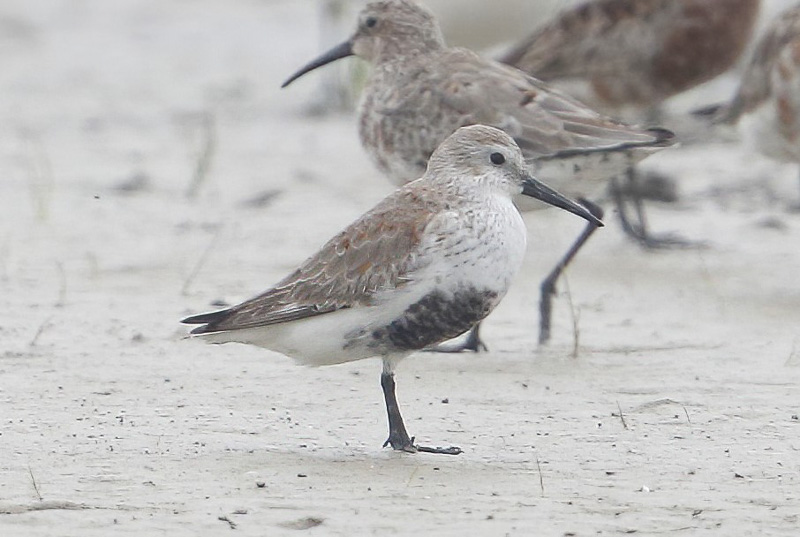Dunlin Calidris alpina 黑腹濱鷸
Category I. Abundant winter visitor, scarce on passage.
IDENTIFICATION

Dec. 2020, Kenneth Lam. Non-breeding plumage.
16-22 cm. Small to medium sized calidrid and the most abundant wintering sandpiper. In all plumages has black legs and relatively long bill that is slightly decurved near the tip. Compared to Curlew Sandpiper the legs are shorter, the bill less decurved and the rump is not wholly white.
Non-breeding plumage is rather plain grey-brown above with streaking on the crown and slightly darker lores and whitish below with faint streaks across the chest. Contrasting clear-cut pale fringes to wing coverts are shown by birds early in their first winter, prior to replacement.

Apr. 2014, Martin Hale. Moulting into breeding plumage.
In breeding plumage has pale head, rufous on upperpart feathers and black belly patch.
VOCALISATIONS
The commonly uttered flight call is a rather dry trill.
DISTRIBUTION & HABITAT PREFERENCE
Most records are from the Deep Bay intertidal mudflats; however, the winter roost area is not at Mai Po NR, where Dunlin is relatively rare. The small numbers on passage in the spring, however, join other migrant waders in roosting flocks on the reserve. Elsewhere, there are a relatively small number of records of up to seven birds from scattered coastal localities during the period 20 September to 13 January, apart from 17 at Tai Po on 15 December 1979. It has also occurred at Long Valley, Chek Lap Kok, Sha Tau Kok and occasionally on fish ponds.
OCCURRENCE
Abundant winter visitor but scarce on passage. The earliest bird in autumn occurred 26 July 2017, though as numbers remain in single figures until mid-September there appears to be little passage; given that HK lies at the southern edge of the species’ wintering range in east Asia, this is not surprising. Instead, numbers build up slowly during the latter part of September, but more appreciably during October and November, by the end of which month the wintering flock is largely established.
In the 1990s winter numbers were relatively high, in the first ten years of this century rather low and in the second decade notably high (Figure 1). Although the occurrence of the small wader flock in front of the boardwalk hide at Mai Po is somewhat erratic, such a prolonged period of low numbers is probably a real phenomenon. The highest count on the HK side of Deep Bay is 6,070 on 13 December 2020, with 6,141 in the whole of Deep Bay on the same date. That numbers of this species have remained high despite climate-change induced milder winters is perhaps surprising given that HK lies at the southern edge of its winter distribution.
Numbers apparently decline markedly at the end of February and during the first half of March, when the highest count this century is 590 (2,000 historically). Numbers in April are generally very low, with only one to three birds present (often in full breeding plumage), though as many as 20 have been noted during the first week of the month and 13 in the second week. No more than two have been noted on any date in May, with the latest record 20 June 2003. There are no records of summering birds.
Vaughan and Jones (1913) stated that Dunlin was an ‘exceedingly common’ winter visitor to the coast and Pearl River delta, with smaller numbers inland. Dove and Goodhart (1955) recorded it from 19 August to 2 May singly or in small parties.
BEHAVIOUR, FORAGING & DIET
The wintering flock remains almost exclusively in the intertidal areas of Deep Bay and utilises unknown roosting areas, presumably on the north side of Deep Bay given the lack of records in HK. Has a tactile feeding strategy on intertidal invertebrates.
RANGE & SYSTEMATICS
Holarctic species breeding largely north of the Arctic Circle; winters south to about 10oN (Warnock and Gill 2020). In China a migrant through eastern areas to winter on the south coast, including Hainan and Taiwan (Liu and Chen 2021).
Ten subspecies are recognised of which three are more likely to occur in HK: C. a. sakhalina, C. a. kistchinski and C. a. actites, which breed from east Russia to the Sea of Okhotsk and the Kuriles and winter in east Asia.
CONSERVATION STATUS
IUCN: NEAR-THREATENED. Population decreasing BY 20-29% over three generations.
Figure 1.

Dove, R. S. and H. J. Goodhart (1955). Field observations from the Colony of Hong Kong. Ibis 97: 311-340.
Liu, Y. and S. H. Chen (eds) (2021). The CNG Field Guide to the Birds of China (in Chinese). Hunan Science and Technology Publication House, Changsha.
Vaughan, R. E. and K. H. Jones (1913). The birds of Hong Kong, Macao and the West River or Si Kiang in South-East China, with special reference to their nidification and seasonal movements. Ibis 1913: 17-76, 163-201, 351-384.
Warnock, N. D. and R. E. Gill (2020). Dunlin (Calidris alpina), version 1.0. In Birds of the World (S. M. Billerman, Editor). Cornell Lab of Ornithology, Ithaca, NY, USA. https://doi.org/10.2173/bow.dunlin.01

